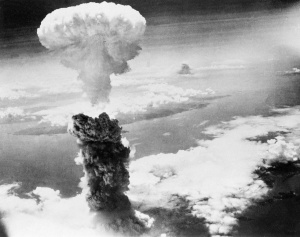Difference between revisions of "Nuclear Deterrence Theory"
m |
|||
| Line 1: | Line 1: | ||
[[File:FWBGISHILZF2RIICDQT5KIROJA-1.jpg|thumbnail|Mushroom cloud over Nagasaki, Japan, after second bomb to hit was dropped, Aug. 9, 1945.]] | [[File:FWBGISHILZF2RIICDQT5KIROJA-1.jpg|thumbnail|Mushroom cloud over Nagasaki, Japan, after second bomb to hit was dropped, Aug. 9, 1945.]] | ||
| − | '''Nuclear Weapons''', usually in the form of bombs or warheads, have long been recognized as a catastrophic force of mass destruction. As an ultra-impactful mean to alter the outcome of wars, captured by the aftermath of the atomic bombings of Hiroshima and Nagasaki in 1945, the technology/information on building Nuclear Weapons had become an essential matter of interest for numerous countries(e.g., the Soviet Union, the United Kingdom, France, China) ever since the end of WWII. Such interest(which eventually led to a series of campaign of '''Nuclear proliferation''' among countries)not only attributes to the formidability of Nuclear power, but more importantly the potential stability and order that could have been provided to the globe after wartime<ref>Kenneth Waltz, “The Spread of Nuclear Weapons: More May Better,” Adelphi Papers, Number 171 (London: International Institute for Strategic Studies, 1981) https://www.mtholyoke.edu/acad/intrel/waltz1.htm</ref>, as proposed by the American Economist Thomas Schelling’s '''“Nuclear Deterrence Theory”'''—the idea | + | '''Nuclear Weapons''', usually in the form of bombs or warheads, have long been recognized as a catastrophic force of mass destruction. As an ultra-impactful mean to alter the outcome of wars, captured by the aftermath of the atomic bombings of Hiroshima and Nagasaki in 1945, the technology/information on building Nuclear Weapons had become an essential matter of interest for numerous countries(e.g., the Soviet Union, the United Kingdom, France, China) ever since the end of WWII. Such interest(which eventually led to a series of campaign of '''Nuclear proliferation''' among countries)not only attributes to the formidability of Nuclear power, but more importantly the potential stability and order that could have been provided to the globe after wartime<ref>Kenneth Waltz, “The Spread of Nuclear Weapons: More May Better,” Adelphi Papers, Number 171 (London: International Institute for Strategic Studies, 1981) https://www.mtholyoke.edu/acad/intrel/waltz1.htm</ref>, as proposed by the American Economist Thomas Schelling’s '''“Nuclear Deterrence Theory”'''—the idea that multiple countries simultaneously possessing the ruinous nuke force would actually deter the use of Nuclear Weapons among Nuclear-owned countries, backed up by an explicit mismatch between, intuitively, “a conceivable defense system” and “the speed with which nuclear weapons can be deployed”, according to Schelling<ref> Schelling, T. C. (1966), "2", The Diplomacy of Violence, New Haven: Yale University Press, pp. 1–34</ref>. |
| − | As for now, “Nuclear Deterrence Theory” is adopted by most countries that have acquired the capability of building nuke weapons(i.e., Nine nations have developed the intelligence to create and possess nuclear power), and hence the ethical issues | + | As for now, “Nuclear Deterrence Theory” is adopted by most countries that have acquired the capability of building nuke weapons(i.e., Nine nations have developed the intelligence to create and possess nuclear power), and hence the ethical issues(e.g., "Is using Nuclear Weapons permissible under certain circumstances such as the case of Japanese Fascism and Militarism practicing?", "Is it ethical to implement nuclear deterrence/threatening to use atomic weapons as a self-defense strategy such as the case of North Korea?") associated with these weapons become increasingly critical and relevant to mankind’s interest. |
Revision as of 15:40, 28 January 2022
Nuclear Weapons, usually in the form of bombs or warheads, have long been recognized as a catastrophic force of mass destruction. As an ultra-impactful mean to alter the outcome of wars, captured by the aftermath of the atomic bombings of Hiroshima and Nagasaki in 1945, the technology/information on building Nuclear Weapons had become an essential matter of interest for numerous countries(e.g., the Soviet Union, the United Kingdom, France, China) ever since the end of WWII. Such interest(which eventually led to a series of campaign of Nuclear proliferation among countries)not only attributes to the formidability of Nuclear power, but more importantly the potential stability and order that could have been provided to the globe after wartime[1], as proposed by the American Economist Thomas Schelling’s “Nuclear Deterrence Theory”—the idea that multiple countries simultaneously possessing the ruinous nuke force would actually deter the use of Nuclear Weapons among Nuclear-owned countries, backed up by an explicit mismatch between, intuitively, “a conceivable defense system” and “the speed with which nuclear weapons can be deployed”, according to Schelling[2].
As for now, “Nuclear Deterrence Theory” is adopted by most countries that have acquired the capability of building nuke weapons(i.e., Nine nations have developed the intelligence to create and possess nuclear power), and hence the ethical issues(e.g., "Is using Nuclear Weapons permissible under certain circumstances such as the case of Japanese Fascism and Militarism practicing?", "Is it ethical to implement nuclear deterrence/threatening to use atomic weapons as a self-defense strategy such as the case of North Korea?") associated with these weapons become increasingly critical and relevant to mankind’s interest.- ↑ Kenneth Waltz, “The Spread of Nuclear Weapons: More May Better,” Adelphi Papers, Number 171 (London: International Institute for Strategic Studies, 1981) https://www.mtholyoke.edu/acad/intrel/waltz1.htm
- ↑ Schelling, T. C. (1966), "2", The Diplomacy of Violence, New Haven: Yale University Press, pp. 1–34
